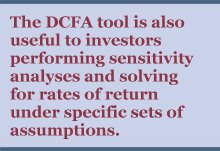

|
207 Abbey Lane Lansdale, Pennsylvania 19446 215-855-1800 |
5201 Ocean Avenue #2007 Wildwood, New Jersey 08260 215-990-6663 |
Specializing in Real Estate Appraisal and Property Tax Consulting
A Professional Courtesy of:
|

Specializing in Real Estate Appraisal and Property Tax Consulting |
| AUTUMN 2009 |
 |
|
In This Issue: |
|
Discounted Cash-flow Analysis The market value of income-producing real estate is derived from two sources, namely the annual cash flow during ownership and the proceeds from resale at the end of the holding period. Discounted cash-flow analysis (DCFA) is an often-used technique for the conversion of such future benefits into an opinion of present value. The use of DCFA was a laborious undertaking before computer-generated spreadsheets became widely available. If changes were made in the underlying assumptions, the task became even more daunting. Since computerization, the utilization of DCFA has become both far easier and more widespread. The DCFA is a particularly important tool when cash-flow forecasts vary significantly during the period of ownership. Such variance may be attributable to unstabilized occupancy, significant lease expiration(s), and contract-rental rates significantly above or below market rates. 
The DCFA tool is also useful to investors performing sensitivity analyses and solving for rates of return under specific sets of assumptions. Further, DCFA can be used to value partial interests (e.g., the mortgage interest and the equity interest). Criticism of DCFA generally is based on the assertion that the numerous assumptions required are speculative forecasts that may or may not come to pass. However, such arguments are not well founded. Investors and lenders do in fact make such forecasts in arriving at pricing decisions. Thus, the proper use of the DCFA technique mirrors the thought processes of market participants. The basic structure of the DCFA model reflects revenue, expenses and nonrecurring costs on a year-by-year basis. Application of the discount rate to such residuals results in the present value of the annual cash flow. The reversionary component is estimated by capitalizing net operating income (NOI) at the end of the holding period, deducting the cost of sale and applying the discount rate. The value estimate is thus the sum of the present worth of the annual cash flows and the reversion. As noted above, numerous assumptions are necessary in the application of DCFA.
For example, it is illogical to conclude that ownership of a single-tenant building will achieve revenue from lease-up on a gradual basis. In such a situation, revenue can be more realistically assumed to commence at the end of the forecast absorption period.

DCFA is a valuable tool for valuation professionals, lenders and investors. Its proper usage depends on careful investigation of both the intrinsic elements of the property being valued and the expectations of investors for similar properties. |
Entrepreneurial Profit Entrepreneurial profit is defined as "a market-derived figure that represents the amount an entrepreneur receives for his or her contribution to a project and risk; the difference between the total cost of a property (cost of development) and its market value (property value after completion), which represents the entrepreneur's compensation for the risk and expertise associated with development" (The Appraisal of Real Estate, 13th edition). The operative word in the foregoing is "receives," in contrast with the term "entrepreneurial incentive," which represents what an entrepreneur expects to receive. The latter is prospective while the former is an accomplished fact. The above source further differentiates profit into the following categories:
In terms of the components of market-value hierarchy, entrepreneurial profit generally has last claim of all the agents of asset creation (i.e., behind materials, labor, land and capital). In practice, developing opinions of appropriate entrepreneurial profit may be made difficult by the need to accurately abstract the other forms of profits described previously. Similarly, the estimation of entrepreneurial profit at various points in the developmental process can be quite difficult (i.e., at what point and to what degree is such profit earned?). Because entrepreneurial profit has last claim on overall project profit, it cannot be said to exist unless the project in question is economically feasible. |
Real Estate in the Current Economic Downturn The current recession has negatively affected virtually all asset classes, including income-producing real estate (alternately referred to simply as "real estate," "income property" and "commercial property"). The following describes some of the reasons for decline, general investment characteristics of such property and likely changes as income property emerges from the current recession. 
Real estate "bubbles," including that which recently occurred, involve high degrees of leverage (loan-to-value ratios), excessive and inexpensive debt capital and aggressive assumptions regarding revenue growth, all of which result in unsustainably high valuations. One must also appreciate the fact that commercial real estate is directly influenced by an almost unknowable number of variables extrinsic to property. Such variables are local, national and international in nature. One key variable is consumer spending, which accounts for more than two-thirds of U.S. economic activity. When consumer spending contracts, demand for retail property also declines. A significant determinant of demand for commercial property is the growth or contraction in employment. Job growth and the resulting growth in spending by both consumers and businesses increase demand for office, retail, multifamily and industrial space. In severe recessionary periods, it becomes quite apparent that commercial real estate has no intrinsic value. Rather, its value is proportional to the degree to which it satisfies the needs of users of such properties. Thus, the notion that real estate is a "hard asset," with all that this term implies, is spurious. 
A significant but common, error in income property market analyses is the failure to fully consider the impact of marked decreases in demand. Many market participants place an inordinate focus on current and likely future changes in supply. However, the recession of 2001, as well as the current one, caused just such a demand contraction. Immediately prior to the onset of these recessions, supply and demand were in equilibrium. In the aftermath of the current recession, we will likely see fundamental changes in the buying, selling and financing of income property. Buyers will require higher investment returns for the following reasons:
The securitization of real estate debt must also change in order for such debt to return to favor with investors, Specifically, originators of securitized debt may be compelled to retain "B-piece" positions in such issues; investors will demand this alignment of interests. Heretofore, originators typically had no exposure to defaults on loans they made. While commercial real estate will almost certainly be subject to "bubbles" at some point in the future, the recently learned hard lessons will likely temper expectations for commercial real estate for years to come. |
Indirect Costs 
Indirect costs, also called "soft costs," are "expenditures or allowances for items other than labor and materials that are necessary for construction but are not typically part of the construction contract. Indirect costs may include administrative costs; professional fees; financing costs and the interest paid on construction loans; taxes and builders' or developer's all-risk insurance during construction; and marketing, sales and lease-up costs incurred to achieve occupancy or sale" Indirect costs may be fixed, variable or semi variable. In order to comprehensively estimate such costs, a detailed breakdown is recommended. When relying on cost-estimating services, the valuation professional must clearly understand which indirect costs are included or excluded. When relying on actual and/or budgeted project costs, care also must be taken to ensure the accurate estimation of indirect costs. Like the physical components of a property, both indirect costs and entrepreneurial profit depreciate over the economic life of the asset. |
|
Next Issue: |
Home | Newsletters | About Us | Contact Us |